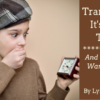
Helping Kids Transition From One Activity to the Next

When a child becomes so focused on a favorite activity that they just can’t seem to pull away, it may become an exercise in frustration for parents. Suddenly, Mom or Dad may find themselves heading directly toward power struggles and conflict as they attempt to move their child onto the next activity.
A mom who had taken the Discipline That Connects online course recently shared some strategies for creating peace in the midst of what had become a repeatedly challenging situation.
Her daughter, Karina, 5 years old, loves to read and sometimes getting her to transition to bedtime became a power struggle. Read to learn how Laura was able to calmly and wisely help her daughter transition to bedtime without conflict, while teaching her some important lessons in the process.
The Transition Struggle: “I don’t want to stop what I’m doing!”
“We were getting ready for bed and our 5 year old, Karina, wouldn’t stop reading her books so we could do family cuddles and prayer time. I gave her the opportunity to mark her page as she put the book away, but when she choose not to I put the book away and she lost her spot. She got really upset at this, so I said firmly, “I’d like you to think about this in your room for a couple of minutes, and I’ll do the same,” and guided her to her room.
Taking Time in Transition: Parent and Child Reflection
After the two minutes I went in to talk to Karina and asked her a relaxed, thoughtful question – “So how do you think things went just now?” Because she had time to think about it calmly, she said “Mommy, you gave me the chance to mark the page and now I lost my page because I didn’t do that when you asked me to. And, I missed out on family cuddles with Daddy and Evan.”
Instead of focusing on her mistake, I admitted, “I wish I had used a calmer voice and let you walk to your room yourself.” I added, “The only person who is perfect is Jesus and even moms and dads have to practice to respond the way we want to.”
A Forward-Thinking Solution for Helping Kids Transition
Karina was really sad because she had missed prayer time with her brother and her father. I said, “What do you think if we told them we were sorry for what happened, and asked for a second chance to do prayer time and cuddles?” She apologized to her dad and brother for her big reaction, and then did some cuddles and prayer time with the family.
As I tucked her in, I said, “It’s important for us to keep talking like this – even when you are a teenager!” Karina smiled and agreed.
Transitions: Practical Application
Laura’s response gives many good ideas for responding to kids who can’t stop doing what they love –
- Give an opportunity to resume the activity later. Earmark the page, put the toy in a special spot. Let your child know you care about her activity.
- Follow through with the logical consequence of losing the item. Laura did not placate her angry daughter by scrambling to find the page again.
- If your child gets upset, structure time for both of you to think. This feels quite different than “Go to your room!”
- Ask a thoughtful question. When you gently ask, “How do you think that went?” it sets both of you up to gain some wisdom about the situation.
- Humbly admit what you wish you’d done differently. This often prompts your child to sincerely apologize, which is much more effective than trying to convince your child that they “messed up.”
- Give an invitation to repair relationships and reconnect.
- Paint a positive future of growing and communicating well together!
Valuable Lessons: What’s Behind the Transition Strategy
What’s really important is that children treated like this learn some valuable lessons –
- Mom or Dad love me enough to follow through with what they say.
- None of us are perfect, we all need grace.
- We are each responsible to repair our relationships when we mess up.
- Mom or Dad is excited to a grow a connected, open relationship with me through all stages of life!
Imagine if your child were well equipped with those lessons as they grow older…
My Response:
Of these ideas, what idea stands out to me in how Laura navigated this challenge with her daughter?
What is a conflict I have with one of my kids, and how do I want to apply this idea?

Know your strengths.
Your best mom or dad instincts are exactly what your kids need. So identify them. Take the free Parenting Strengths Assessment.






